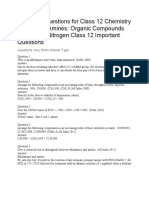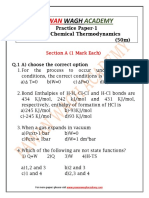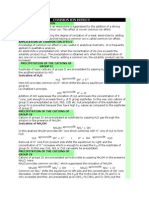Plant Water Relation: Grade 12
Plant Water Relation: Grade 12
Uploaded by
jovellamCopyright:
Available Formats
Plant Water Relation: Grade 12
Plant Water Relation: Grade 12
Uploaded by
jovellamOriginal Description:
Original Title
Copyright
Available Formats
Share this document
Did you find this document useful?
Is this content inappropriate?
Copyright:
Available Formats
Plant Water Relation: Grade 12
Plant Water Relation: Grade 12
Uploaded by
jovellamCopyright:
Available Formats
Plant water relation
Grade 12
Structure of a seed
Types of seed germination
LE 38-10a
Foliage leaves
Cotyledon
Cotyledon
Hypocotyl
Hypocotyl
Radicle
Seed coat
Hypocotyl
Cotyledon
Epicotyl
Common garden bean
LE 38-10b
Foliage leaves
Coleoptile
Radicle
Maize
Coleoptile
Transport
Summary
A=absorption / assimilation
L=loading
U=unloading
I=interchange
Opening & closing of stomata
Day time
Carbob dioxide in guard cells utilised for
photosynthesis.
Sap becomes alkaline & in this medium starch
gets converted to sugar
Guard cells : sugar (chloroplast)
Sugar soluble in sap-osmotic potential of cell
increases
Water from sorrounding cells enter guard cells
By osmosis
Water exerts pressure on thin wall of guard cells
from inside.
Hence thin walls bulge outward, pulling apart
innerthick walls , opening the stomata
Night time
No photosynthesis
Carbondioxide accumulates in guard cells
Sap becomes acidic
In this sugar gets converted to starch
Being insoluble in water osmotic potential
becomes less compared to surrounding
Surrounding cells take out water from guard cells
by osmosis making them flaccid
Hence outer thin walls come to their original
position, closing the stomata.
Significance of Transpiration
Absorption of water
Transpiration influences the rate of absorption of water from the soil.
Water movement
By transpiration, water moves upwards and as it passes into the cell
vacuoles, it makes the cells turgid. This gives form and shape to cells
and plant as a whole.
Mineral salt transport
The water stream moving upwards carries dissolved minerals with it.
Transpiration also helps in distributing these minerals throughout the
plant.
Cooling
The evaporation of water during transpiration cools the leaves.
Protection from heat injury
Some plants like cacti, retain water by reducing transpiration. This
saves the plants from high temperatures and strong sunlight.
Factors Affecting Rate of
Transpiration - External factors
Temperature
Higher the temperature more is the transpiration.
Light
Light causes stomata to open and hence increase
the water loss from plant
Availability of soil water
When the soil gets dry, soil solution
becomes more concentrated and the
rate of absorption by cells decreases.
This leads to reduction in transpiration
and stomata close quickly to keep the
water loss to minimum.
Atmospheric humidity
High humidity means high water
Vapour pressure outside and it results
in lower rate of transpiration and as the
humidity decreases rate of transpiration
increases.
.
Wind
The wind removes water vapour and thus
increases the rate of transpiration. High winds
lead to stomatal closure to stop the rapid water
loss and hence bring a drop in rate of
transpiration. Moderate winds may also reduce
transpiration by lowering the temperature of
leaf.
Atmospheric pressure
Lower the atmospheric pressure, higher is the
rate of transpiration
You might also like
- Chemistry +2hhsliveDocument76 pagesChemistry +2hhsliveNaVaneeth :/No ratings yet
- Solutions Class 12th Practice Paper 1Document6 pagesSolutions Class 12th Practice Paper 1Liyutsa ZirangeNo ratings yet
- Class 12 - Chapter 1 Mathematical LogicDocument24 pagesClass 12 - Chapter 1 Mathematical LogicFarzana HannureNo ratings yet
- DAK10603 Thermodynamic: Thermodynamics SystemsDocument17 pagesDAK10603 Thermodynamic: Thermodynamics SystemsFattihiEkhmalNo ratings yet
- Chemistry Ch.3Document14 pagesChemistry Ch.3OmlNo ratings yet
- P BlockDocument52 pagesP BlockYogendra GangwarNo ratings yet
- 11 Biology Notes Ch15 Plant Growth and DevelopmentDocument8 pages11 Biology Notes Ch15 Plant Growth and DevelopmentAnkush priyadarshiNo ratings yet
- Electrochemistry Class 12 NotesDocument53 pagesElectrochemistry Class 12 NotesGirish Arora50% (2)
- Chemistry Notes For Class 12 Chapter 9 Coordination CompoundsDocument11 pagesChemistry Notes For Class 12 Chapter 9 Coordination CompoundsYASH SONARNo ratings yet
- 12 Chemistry Notes ch13 AminesDocument11 pages12 Chemistry Notes ch13 AminesAkNo ratings yet
- Class 12 Chemical Kinetics Revision NotesDocument4 pagesClass 12 Chemical Kinetics Revision NotesTushar AggarwalNo ratings yet
- Amines Important QuestionsDocument34 pagesAmines Important QuestionsK KANNANNo ratings yet
- CBSE Class 12 Chemistry Sure Shot QuestionsDocument57 pagesCBSE Class 12 Chemistry Sure Shot Questionsconnectrishabh666100% (1)
- CH 8 Class 12 Chem PDFDocument12 pagesCH 8 Class 12 Chem PDFDhanushNo ratings yet
- CBSE Class 12 Biology Chapter 9 Strategies For Enhancement in Food Production Revision NotesDocument24 pagesCBSE Class 12 Biology Chapter 9 Strategies For Enhancement in Food Production Revision Notesaayushjaiswal1070No ratings yet
- Class 12th Chemistry Chapter 3 (Electrochemistry) Important Unsolved QuestionsDocument9 pagesClass 12th Chemistry Chapter 3 (Electrochemistry) Important Unsolved QuestionsI L0vE SHiTNo ratings yet
- STD Xii: AC CircuitsDocument22 pagesSTD Xii: AC CircuitsAmish ShahNo ratings yet
- Kset Chemistry PaperDocument16 pagesKset Chemistry Papersharanu hiremathNo ratings yet
- Standard Hydrogen ElectrodeDocument2 pagesStandard Hydrogen ElectrodeAmmara Amy100% (1)
- Surface Chemistry Notes For Class 12 Board ExamsDocument14 pagesSurface Chemistry Notes For Class 12 Board ExamsKartik JhirwarNo ratings yet
- 8.transition and Inner Transition ElementsDocument69 pages8.transition and Inner Transition Elementsdevrarimanish72No ratings yet
- Class - 12 Chemistry - AminesDocument34 pagesClass - 12 Chemistry - AminesAnonymous RuslwNZZlNo ratings yet
- MOST IMP DERIVATION With SOLUTIONDocument125 pagesMOST IMP DERIVATION With SOLUTIONrohitkakad2006No ratings yet
- Wave Optics NotesDocument16 pagesWave Optics NotesNarenNo ratings yet
- CBSE Class-12 Chemistry Quick Revision Notes Chapter-03: ElectrochemistryDocument6 pagesCBSE Class-12 Chemistry Quick Revision Notes Chapter-03: ElectrochemistrySAKET TYAGI100% (1)
- Class XI Biology Study Material 2022-23-1Document257 pagesClass XI Biology Study Material 2022-23-1ysNo ratings yet
- Mechanical Properties of FluidsDocument5 pagesMechanical Properties of FluidsSteveMathewKuruvillaNo ratings yet
- Respiration and Circulation: Secondary 2, Biology, Chapter 3Document7 pagesRespiration and Circulation: Secondary 2, Biology, Chapter 3Deddy KismanaNo ratings yet
- Abhishek Thakur Xi-F 15 Physics Project File: Mechanical Properties of FluidsDocument14 pagesAbhishek Thakur Xi-F 15 Physics Project File: Mechanical Properties of FluidsAbhishek ThakurNo ratings yet
- DEEPER - Print Hall TicketDocument1 pageDEEPER - Print Hall Ticketkapilb759No ratings yet
- 11 Chemistry Notes Ch04 Chemical Bonding and Molecular StructureDocument25 pages11 Chemistry Notes Ch04 Chemical Bonding and Molecular StructureRoyNo ratings yet
- Elements of Group 16Document30 pagesElements of Group 16VishalNo ratings yet
- Respiration in PlantsDocument22 pagesRespiration in PlantsTabada NickyNo ratings yet
- ElectrochemistryDocument78 pagesElectrochemistryNik Muhammad Firdaus100% (1)
- Respiration in PlantsDocument6 pagesRespiration in PlantsjanakiramannadesanNo ratings yet
- Class 12 Physics Ch-6 NotesDocument5 pagesClass 12 Physics Ch-6 Notesrm6851447No ratings yet
- Vivekanand Jr. College / New Model, Kolhapur: Shri Swami Vivekanand Shikshan Sanstha'sDocument2 pagesVivekanand Jr. College / New Model, Kolhapur: Shri Swami Vivekanand Shikshan Sanstha'sSherlyn ChopraNo ratings yet
- First Prelim EnglishDocument10 pagesFirst Prelim EnglishUmesh SalveNo ratings yet
- Chemistry Class 12 Investigatorty ProjectDocument24 pagesChemistry Class 12 Investigatorty Projectzeeshan khan زشان خانNo ratings yet
- Class 12 Maths Formula Chapter-9Document2 pagesClass 12 Maths Formula Chapter-9SAURABH SAHUNo ratings yet
- Chemistry Notes Class 11 Chapter 8 Redox ReactionsDocument9 pagesChemistry Notes Class 11 Chapter 8 Redox ReactionsKaleelur Rahman100% (1)
- Chemical Thermodynamics Class 12th Practice PaperDocument8 pagesChemical Thermodynamics Class 12th Practice PaperLiyutsa Zirange0% (1)
- Notes For Chemistry Class 12 Chapter 13 AminesDocument22 pagesNotes For Chemistry Class 12 Chapter 13 AminesVanshika JainNo ratings yet
- Revision Booklet Physical Chemistry Class 12Document11 pagesRevision Booklet Physical Chemistry Class 12KRITHIKA .MNo ratings yet
- 12 TH Chemistry Assignment 7 Elements of Group 16,17,18Document4 pages12 TH Chemistry Assignment 7 Elements of Group 16,17,18ritesh sakhareNo ratings yet
- Morphology of Flowering Plants - Chapter Notes - NotesDocument9 pagesMorphology of Flowering Plants - Chapter Notes - NotesAAYUSH THAKURNo ratings yet
- Chapter 8 Jan13Document89 pagesChapter 8 Jan13kumutha100% (1)
- Rotational DynamicDocument20 pagesRotational DynamicHarshad ShelkeNo ratings yet
- Army Public School Gopalpur: Class-Xii Science Subject - Biology Chapter-4 Reproductive Health NotesDocument5 pagesArmy Public School Gopalpur: Class-Xii Science Subject - Biology Chapter-4 Reproductive Health NotesAshok KumarNo ratings yet
- Chemistry Notes For Class 12 Chapter 4 Chemical KineticsDocument11 pagesChemistry Notes For Class 12 Chapter 4 Chemical KineticsAyush singh PrinceNo ratings yet
- 11 Chemistry Notes Ch07 EquilibriumDocument4 pages11 Chemistry Notes Ch07 EquilibriumRangbaaz DA FIRENZENo ratings yet
- 1 Rotational Dynamics PDF PrintDocument22 pages1 Rotational Dynamics PDF PrintHarshal Mankar0% (1)
- CBSE Class 12 Biology Chapter 5 Principles of Inheritance and Variation Revision NotesDocument35 pagesCBSE Class 12 Biology Chapter 5 Principles of Inheritance and Variation Revision NotesAnkur YadavNo ratings yet
- Common Ion EffectDocument2 pagesCommon Ion EffectAlexander MartinNo ratings yet
- Life ScienceDocument5 pagesLife Sciencegurpreet KaurNo ratings yet
- Transport System in PlantsDocument59 pagesTransport System in Plantsskye.raylene.williamsNo ratings yet
- Support and Transport System in PlantsDocument24 pagesSupport and Transport System in PlantsmashingarsandileNo ratings yet
- TranspirationDocument3 pagesTranspirationKENNETH POLONo ratings yet
- Chapter 8 Lesson 2 Transpiration and TranslocationDocument20 pagesChapter 8 Lesson 2 Transpiration and TranslocationAli waleed AbdalmoatyNo ratings yet
- PP11 Transport System in Plants 1460451147Document59 pagesPP11 Transport System in Plants 1460451147ayandaskosana165No ratings yet



























































